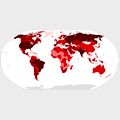Search results
Dec 23, 2021 · When do infected people transmit the virus? What is the difference between people who are asymptomatic or pre-symptomatic? Don’t they both mean someone without symptoms? Are there certain settings where COVID-19 can spread more easily? How can I reduce my risk of getting COVID-19? The English version was updated on 23 December 2021.
- We know that the disease is caused by the SARS-CoV-2 virus, which spreads between people in several different ways. Current evidence suggests that...
- Whether or not they have symptoms, infected people can be contagious and the virus can spread from them to other people. Laboratory data suggests t...
- Both terms refer to people who do not have symptoms. The difference is that ‘asymptomatic’ refers to people who are infected but never develop any...
- Yes, any situation in which people are in close proximity to one another for long periods of time increases the risk of transmission. Indoor locati...
- There are many things you can do to keep yourself and your loved ones safe from COVID-19. Know your risks to lower risks. Follow these basic precau...
- Overview
- How does it spread from person to person?
- Why do some variants spread more easily?
- Can the virus spread more easily in certain settings?
- Can someone spread the virus even if they don’t have symptoms?
- Can you still spread the virus if you’re vaccinated?
- Can you pick it up from infected surfaces?
- How to protect yourself
- What are the symptoms?
- The bottom line
Like many others, you probably have questions about the novel coronavirus. And one of those questions may have to do with how the virus is able to spread.
First, some brief explanation about the coronavirus itself: The clinical name for this coronavirus is SARS-CoV-2. It stands for “severe acute respiratory syndrome coronavirus 2,” which means it’s a respiratory virus and is transmitted through respiratory droplets.
The infection caused by this virus is called COVID-19. So, if a person contracts the virus, the resulting disease is called COVID-19.
It originated from a family of other viruses that causes respiratory diseases like severe acute respiratory syndrome (SARS) and Middle East respiratory syndrome (MERS).
Because this coronavirus is so new, it’s unfamiliar to our immune systems. And for nearly a year after the COVID-19 pandemic began, there wasn’t a vaccine to help protect you from this virus.
However, today there are three COVID-19 vaccines available in the United States:
To curb COVID-19 transmission, the Centers for Disease Control and Prevention (CDC) recommends wearing a well-fitted face mask if you’re:
•not fully vaccinated (this applies to anyone 2 years of age and older)
•fully vaccinated and have a weakened immune system, whether from medication or an underlying health condition
•fully vaccinated and are in a region with a high COVID-19 transmission or case rate
According to the CDC, you typically don’t need to wear a mask in outdoor areas, unless you’re in close contact with people who aren’t fully vaccinated or in a crowded outdoor space.
Was this helpful?
According to the CDC, the Delta variant (also known as B.1.617.2), which was first detected in India, spreads more easily and causes more infections than earlier versions of SARS-CoV-2.
In fact, the Delta variant is believed to be twice as infectious as other versions of the novel coronavirus. Some experts suggest that mutations, such as changes to the virus’s spike protein, may make the altered virus (the variant) stick more tightly to our cells once the virus invades the body.
We know that the coronavirus spreads more easily indoors in poorly ventilated spaces.
According to the Environmental Protection Agency, respiratory droplets containing the virus can accumulate indoors and spread more easily than in outdoor spaces.
Yes. You can transmit the coronavirus even if you don’t know you have an infection.
Experts believe it’s possible that someone with a coronavirus infection could transmit it to others even if they don’t show any symptoms, or have such mild symptoms that they don’t really know they’re sick.
In fact, an analysis published in early 2021 suggested that asymptomatic transmission was responsible for more than half the COVID-19 cases in the eight studies from which the researchers pulled data.
Someone who has contracted the coronavirus can transmit it when they’re showing symptoms. But someone may be able to transmit the virus even before they start to show COVID-19 symptoms.
The symptoms of COVID-19 can take anywhere from 2 to 14 days to show up after exposure to the virus.
A 2021 study found that the coronavirus is most contagious in the 2 days before and 3 days after a person begins experiencing symptoms.
If you’re fully vaccinated against COVID-19, you are far less likely to contract an infection than someone who is unvaccinated.
If you do contract a breakthrough infection and develop COVID-19, the disease tends to be mild in most vaccinated people. You’re less likely to transmit it to others, too.
Think of all the frequently touched surfaces where germs can lurk: kitchen counters, bathroom counters, doorknobs, elevator buttons, the handle on the refrigerator, handrails on staircases. The list goes on and on.
Early in the pandemic, experts were uncertain how long the coronavirus could survive on those surfaces and whether that posed a threat.
However, in early 2021, the CDC acknowledged that while transmission from contaminated surfaces is possible, “the risk is generally considered to be low.”
But if you think a surface may be contaminated, especially if you know you’re likely to touch it and then touch your face, clean the surface thoroughly with a disinfectant. A diluted bleach solution or an EPA-approved disinfectant is likely the most effective cleaner for this purpose.
And if someone in your home is sick, frequently clean those surfaces. Remember to thoroughly wash your hands afterward.
Summary
It can be difficult to avoid being exposed to the coronavirus, especially if you’re often surrounded by other people or work in a high-risk setting. But, according to the CDC, there are a number of things you can do to protect yourself:
•Get vaccinated. COVID-19 vaccines are safe and effective. In the United States, they are widely available at no cost. You can visit Vaccines.gov to find a vaccination provider near you, or check with retail stores, pharmacies, and medical offices in your area.
•Stand back. Try to stay clear of people who are coughing or sneezing. The CDC suggests staying at least 6 feet away from people who may be sick.
•Wear a mask. Wearing a properly fitting mask indoors may help protect you if you come in contact with someone who has COVID-19.
•Wash your hands frequently. Wash your hands thoroughly with soap and water for at least 20 seconds every time you’ve been around other people or touched common surfaces that could be contaminated.
•Use alcohol-based hand sanitizer. If you don’t have access to soap and water, use a hand sanitizer that’s at least 60 percent alcohol.
COVID-19 causes symptoms that are similar to those of other types of respiratory illnesses. Typical symptoms of COVID-19 include:
•fever
•cough
•shortness of breath
•fatigue
Shortness of breath is more pronounced with COVID-19 compared with the seasonal flu or common cold.
As time passes, experts continue to learn more about the novel coronavirus, how it behaves, and how it’s transmitted.
Now that COVID-19 vaccines are available, public health and infectious disease experts continue to strongly recommend vaccination to everyone who’s eligible, which now includes children from ages 5 on up to older adults.
Additionally, it’s always a good idea to be proactive about handwashing and respiratory hygiene to give yourself the best shot at avoiding or spreading the coronavirus (or any other respiratory virus). The CDC also recommends wearing a mask indoors in areas with high COVID-19 cases.
If you do develop symptoms of COVID-19, call your doctor. This is especially important if you’ve been in contact with someone who already has COVID-19, or if you have symptoms that start getting worse.
The transmission of COVID-19 is the passing of coronavirus disease 2019 from person to person. COVID-19 is mainly transmitted when people breathe in air contaminated by droplets/aerosols and small airborne particles containing the virus. Infected people exhale those particles as they breathe, talk, cough, sneeze, or sing.
Dec 19, 2023 · By understanding how coronavirus spreads, you can take the right steps so you don't get sick and infect others. COVID transmission rate. Recent data from the World Health Organization (WHO)...
Mar 15, 2024 · COVID-19 spreads when an infected person breathes out droplets and very small particles that contain the virus. These droplets and particles can be breathed in by other people or land on their eyes, noses, or mouth. In some circumstances, they may contaminate surfaces they touch. About Variants.
Sep 1, 2020 · Broadly, two modes of transmission of COVID-19 exist—direct and indirect. The direct mode includes (1) transmission via aerosols formed via surgical and dental procedures and/or in the form of respiratory droplet nuclei; (2) other body fluids and secretions, for example, feces, saliva, urine, semen, and tears; and (3) mother-to-child.
Aug 9, 2023 · COVID-19 is the disease caused by the SARS-CoV-2 coronavirus. It usually spreads between people in close contact. COVID-19 vaccines provide strong protection against severe illness and death. Although a person can still get COVID-19 after vaccination, they are more likely to have mild or no symptoms.






